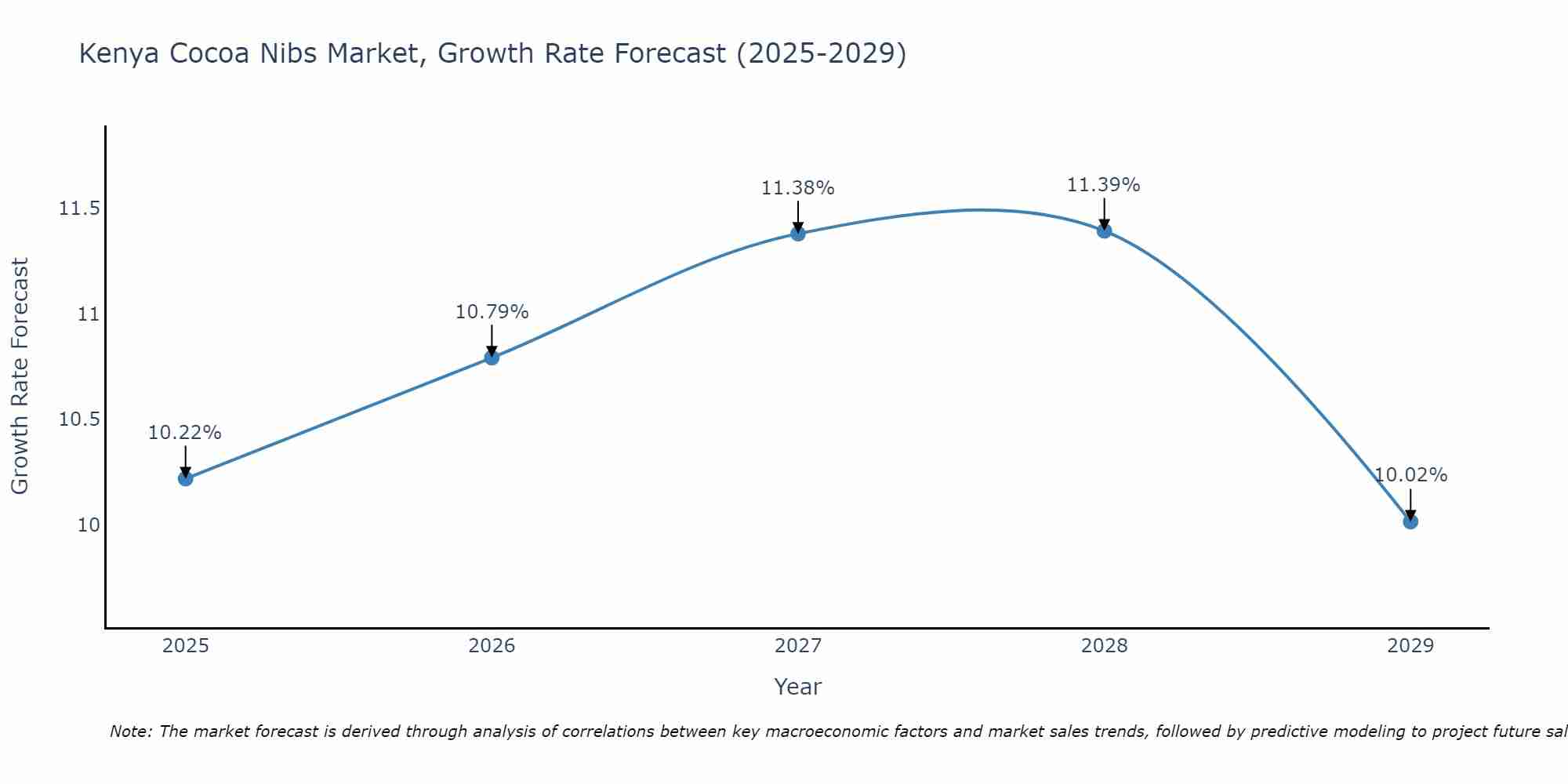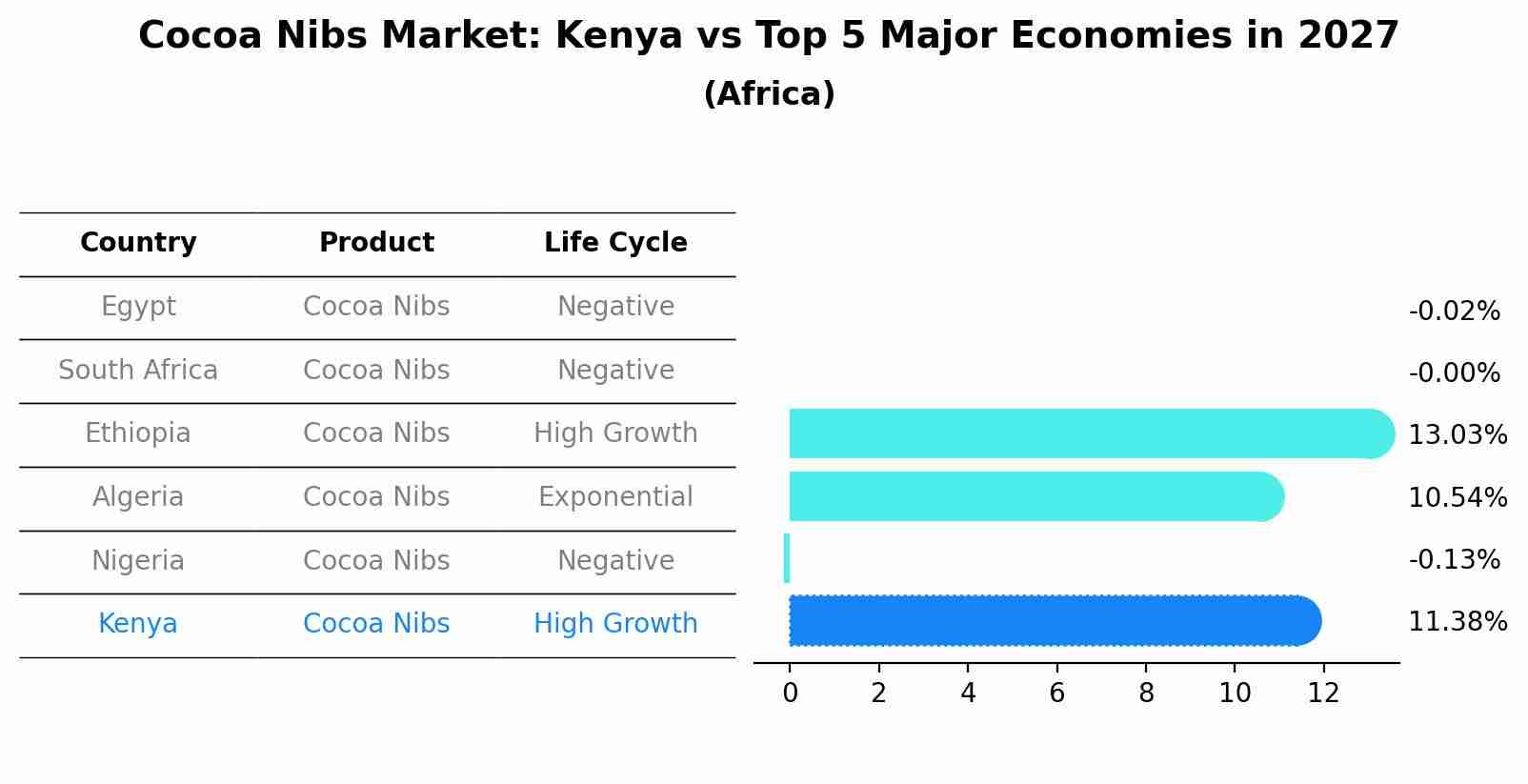Kenya Cocoa Nibs Market Outlook | Growth, Forecast, Companies, Revenue, Industry, Trends, Size, COVID-19 IMPACT, Analysis, Value & Share
| Product Code: ETC107289 | Publication Date: Jun 2021 | Updated Date: Jun 2025 | Product Type: Report | |
| Publisher: 6Wresearch | Author: Dhaval Chaurasia | No. of Pages: 70 | No. of Figures: 35 | No. of Tables: 5 |
Kenya Cocoa Nibs Market Size Growth Rate
The Kenya Cocoa Nibs Market is projected to witness mixed growth rate patterns during 2025 to 2029. The growth rate begins at 10.22% in 2025, climbs to a high of 11.39% in 2028, and moderates to 10.02% by 2029.

Cocoa Nibs Market: Kenya vs Top 5 Major Economies in 2027 (Africa)
In the Africa region, the Cocoa Nibs market in Kenya is projected to expand at a high growth rate of 11.38% by 2027. The largest economy is Egypt, followed by South Africa, Ethiopia, Algeria and Nigeria.

Kenya Cocoa Nibs Market Overview
The Kenya Cocoa Nibs market is experiencing steady growth driven by increasing consumer awareness of the health benefits of cocoa products. Cocoa nibs, which are small pieces of crushed cocoa beans, are rich in antioxidants and are being used in various food and beverage applications such as baking, confectionery, and as a snack. The market is benefiting from the growing demand for natural and organic ingredients, as cocoa nibs are considered a pure and unprocessed form of cocoa. Additionally, the rising popularity of specialty chocolate products and the influence of Western food trends are further fueling the demand for cocoa nibs in Kenya. Key players in the market are focusing on product innovation and marketing strategies to cater to the evolving preferences of consumers and capitalize on the expanding market opportunities.
Kenya Cocoa Nibs Market Trends
Currently, the Kenya Cocoa Nibs market is witnessing a growing demand for organic and sustainably sourced products. Consumers are increasingly seeking out cocoa nibs that are ethically produced, environmentally friendly, and free from harmful chemicals. There is also a rising interest in incorporating cocoa nibs into various food and beverage products, such as snacks, desserts, and beverages, due to their perceived health benefits and unique flavor profile. Additionally, the market is experiencing a trend towards premiumization, with consumers willing to pay a premium for high-quality, gourmet cocoa nibs. As more consumers become health-conscious and interested in exploring new flavors and textures, the Kenya Cocoa Nibs market is expected to continue to expand and diversify in the coming years.
Kenya Cocoa Nibs Market Challenges
In the Kenya Cocoa Nibs market, several challenges are faced that impact the industry`s growth potential. Limited infrastructure, including transportation and storage facilities, hinders the efficient movement of cocoa nibs from farms to processing facilities, leading to delays and quality issues. Inconsistent quality standards and certification processes also pose challenges for both producers and buyers, affecting market transparency and trust. Additionally, fluctuating global cocoa prices and competition from other cocoa-producing regions present economic challenges for Kenyan cocoa nibs producers, making it challenging to remain competitive in the international market. Addressing these challenges through investments in infrastructure, quality control measures, and market diversification strategies is crucial for the sustainable growth of the Kenya Cocoa Nibs market.
Kenya Cocoa Nibs Market Investment Opportunities
In the Kenya Cocoa Nibs market, there are several investment opportunities for both local and international investors. One option is to invest in the production and processing of cocoa beans to extract cocoa nibs, which are increasingly in demand due to their health benefits and culinary uses. Another potential opportunity lies in establishing distribution networks to supply cocoa nibs to the food and beverage industry, artisanal chocolate makers, and health food stores. Additionally, investing in research and development to improve the quality and sustainability of cocoa production in Kenya can also be lucrative. As the global demand for high-quality cocoa products continues to grow, investing in the Kenya Cocoa Nibs market presents a promising opportunity for investors looking to capitalize on this trend.
Kenya Cocoa Nibs Market Government Policy
The Kenyan government does not have specific policies targeting the cocoa nibs market, but rather general agricultural policies that may impact the sector. The government has initiatives in place to support the agricultural sector, including cocoa production, through subsidies, extension services, and infrastructure development. Additionally, the government has been focusing on promoting value addition in agriculture to enhance the competitiveness of local products in both domestic and international markets. However, challenges such as limited access to finance, outdated farming practices, and inadequate processing facilities hinder the growth of the cocoa nibs market in Kenya. Overall, there is potential for the government to further support and incentivize cocoa production and processing to boost the cocoa nibs market in the country.
Kenya Cocoa Nibs Market Future Outlook
The future outlook for the Kenya Cocoa Nibs Market appears promising due to increasing consumer demand for healthier and ethically sourced ingredients. Cocoa nibs, known for their rich flavor and nutritional benefits, are gaining popularity among health-conscious consumers looking for natural and unprocessed products. Additionally, the growing awareness of the health benefits associated with cocoa consumption, such as its antioxidant properties and mood-enhancing effects, is expected to drive the market growth. With Kenya`s favorable climate for cocoa cultivation and the government`s support for the agricultural sector, the country is well-positioned to meet the rising demand for cocoa nibs. As a result, we can anticipate a steady increase in production and export of high-quality cocoa nibs from Kenya in the coming years.
Key Highlights of the Report:
- Kenya Cocoa Nibs Market Outlook
- Market Size of Kenya Cocoa Nibs Market, 2021
- Forecast of Kenya Cocoa Nibs Market, 2027
- Historical Data and Forecast of Kenya Cocoa Nibs Revenues & Volume for the Period 2018 - 2027
- Kenya Cocoa Nibs Market Trend Evolution
- Kenya Cocoa Nibs Market Drivers and Challenges
- Kenya Cocoa Nibs Price Trends
- Kenya Cocoa Nibs Porter's Five Forces
- Kenya Cocoa Nibs Industry Life Cycle
- Historical Data and Forecast of Kenya Cocoa Nibs Market Revenues & Volume By Product for the Period 2018 - 2027
- Historical Data and Forecast of Kenya Cocoa Nibs Market Revenues & Volume By Conventional for the Period 2018 - 2027
- Historical Data and Forecast of Kenya Cocoa Nibs Market Revenues & Volume By Organic for the Period 2018 - 2027
- Historical Data and Forecast of Kenya Cocoa Nibs Market Revenues & Volume By Application for the Period 2018 - 2027
- Historical Data and Forecast of Kenya Cocoa Nibs Market Revenues & Volume By Commercial for the Period 2018 - 2027
- Historical Data and Forecast of Kenya Cocoa Nibs Market Revenues & Volume By Household for the Period 2018 - 2027
- Kenya Cocoa Nibs Import Export Trade Statistics
- Market Opportunity Assessment By Product
- Market Opportunity Assessment By Application
- Kenya Cocoa Nibs Top Companies Market Share
- Kenya Cocoa Nibs Competitive Benchmarking By Technical and Operational Parameters
- Kenya Cocoa Nibs Company Profiles
- Kenya Cocoa Nibs Key Strategic Recommendations
Frequently Asked Questions About the Market Study (FAQs):
1 Executive Summary |
2 Introduction |
2.1 Key Highlights of the Report |
2.2 Report Description |
2.3 Market Scope & Segmentation |
2.4 Research Methodology |
2.5 Assumptions |
3 Kenya Cocoa Nibs Market Overview |
3.1 Kenya Country Macro Economic Indicators |
3.2 Kenya Cocoa Nibs Market Revenues & Volume, 2021 & 2027F |
3.3 Kenya Cocoa Nibs Market - Industry Life Cycle |
3.4 Kenya Cocoa Nibs Market - Porter's Five Forces |
3.5 Kenya Cocoa Nibs Market Revenues & Volume Share, By Product, 2021 & 2027F |
3.6 Kenya Cocoa Nibs Market Revenues & Volume Share, By Application, 2021 & 2027F |
4 Kenya Cocoa Nibs Market Dynamics |
4.1 Impact Analysis |
4.2 Market Drivers |
4.3 Market Restraints |
5 Kenya Cocoa Nibs Market Trends |
6 Kenya Cocoa Nibs Market, By Types |
6.1 Kenya Cocoa Nibs Market, By Product |
6.1.1 Overview and Analysis |
6.1.2 Kenya Cocoa Nibs Market Revenues & Volume, By Product, 2018 - 2027F |
6.1.3 Kenya Cocoa Nibs Market Revenues & Volume, By Conventional, 2018 - 2027F |
6.1.4 Kenya Cocoa Nibs Market Revenues & Volume, By Organic, 2018 - 2027F |
6.2 Kenya Cocoa Nibs Market, By Application |
6.2.1 Overview and Analysis |
6.2.2 Kenya Cocoa Nibs Market Revenues & Volume, By Commercial, 2018 - 2027F |
6.2.3 Kenya Cocoa Nibs Market Revenues & Volume, By Household, 2018 - 2027F |
7 Kenya Cocoa Nibs Market Import-Export Trade Statistics |
7.1 Kenya Cocoa Nibs Market Export to Major Countries |
7.2 Kenya Cocoa Nibs Market Imports from Major Countries |
8 Kenya Cocoa Nibs Market Key Performance Indicators |
9 Kenya Cocoa Nibs Market - Opportunity Assessment |
9.1 Kenya Cocoa Nibs Market Opportunity Assessment, By Product, 2021 & 2027F |
9.2 Kenya Cocoa Nibs Market Opportunity Assessment, By Application, 2021 & 2027F |
10 Kenya Cocoa Nibs Market - Competitive Landscape |
10.1 Kenya Cocoa Nibs Market Revenue Share, By Companies, 2021 |
10.2 Kenya Cocoa Nibs Market Competitive Benchmarking, By Operating and Technical Parameters |
11 Company Profiles |
12 Recommendations |
13 Disclaimer |
- Single User License$ 1,995
- Department License$ 2,400
- Site License$ 3,120
- Global License$ 3,795
Search
Thought Leadership and Analyst Meet
Our Clients
Related Reports
- Canada Oil and Gas Market (2026-2032) | Share, Segmentation, Value, Industry, Trends, Forecast, Analysis, Size & Revenue, Growth, Competitive Landscape, Outlook, Companies
- Germany Breakfast Food Market (2026-2032) | Industry, Share, Growth, Size, Companies, Value, Analysis, Revenue, Trends, Forecast & Outlook
- Australia Briquette Market (2025-2031) | Growth, Size, Revenue, Forecast, Analysis, Trends, Value, Share, Industry & Companies
- Vietnam System Integrator Market (2025-2031) | Size, Companies, Analysis, Industry, Value, Forecast, Growth, Trends, Revenue & Share
- ASEAN and Thailand Brain Health Supplements Market (2025-2031) | Strategy, Consumer Insights, Analysis, Investment Trends, Opportunities, Growth, Size, Share, Industry, Revenue, Segments, Value, Segmentation, Supply, Forecast, Restraints, Outlook, Competition, Drivers, Trends, Demand, Pricing Analysis, Competitive, Strategic Insights, Companies, Challenges
- ASEAN Bearings Market (2025-2031) | Strategy, Consumer Insights, Analysis, Investment Trends, Opportunities, Growth, Size, Share, Industry, Revenue, Segments, Value, Segmentation, Supply, Forecast, Restraints, Outlook, Competition, Drivers, Trends, Demand, Pricing Analysis, Competitive, Strategic Insights, Companies, Challenges
- Europe Flooring Market (2025-2031) | Outlook, Share, Industry, Trends, Forecast, Companies, Revenue, Size, Analysis, Growth & Value
- Saudi Arabia Manlift Market (2025-2031) | Outlook, Size, Growth, Trends, Companies, Industry, Revenue, Value, Share, Forecast & Analysis
- Uganda Excavator, Crane, and Wheel Loaders Market (2025-2031) | Strategy, Consumer Insights, Analysis, Investment Trends, Opportunities, Growth, Size, Share, Industry, Revenue, Segments, Value, Segmentation, Supply, Forecast, Restraints, Outlook, Competition, Drivers, Trends, Demand, Pricing Analysis, Competitive, Strategic Insights, Companies, Challenges
- Rwanda Excavator, Crane, and Wheel Loaders Market (2025-2031) | Strategy, Consumer Insights, Analysis, Investment Trends, Opportunities, Growth, Size, Share, Industry, Revenue, Segments, Value, Segmentation, Supply, Forecast, Restraints, Outlook, Competition, Drivers, Trends, Demand, Pricing Analysis, Competitive, Strategic Insights, Companies, Challenges
Industry Events and Analyst Meet
Whitepaper
- Middle East & Africa Commercial Security Market Click here to view more.
- Middle East & Africa Fire Safety Systems & Equipment Market Click here to view more.
- GCC Drone Market Click here to view more.
- Middle East Lighting Fixture Market Click here to view more.
- GCC Physical & Perimeter Security Market Click here to view more.
6WResearch In News
- Doha a strategic location for EV manufacturing hub: IPA Qatar
- Demand for luxury TVs surging in the GCC, says Samsung
- Empowering Growth: The Thriving Journey of Bangladesh’s Cable Industry
- Demand for luxury TVs surging in the GCC, says Samsung
- Video call with a traditional healer? Once unthinkable, it’s now common in South Africa
- Intelligent Buildings To Smooth GCC’s Path To Net Zero


















